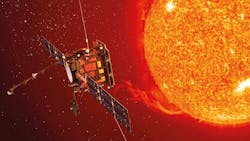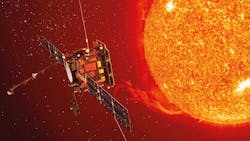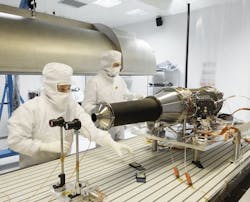Thales Alenia Space delivers METIS instrument, heat shield for ESA Solar Orbiter
ROME. Engineers at Thales Alenia Space, the joint venture of Thales and Leonardo, have completed construction of the heat shield on behalf of Airbus Defence and Space for the European Space Agency’s (ESA’s) Solar Orbiter spacecraft, as well as delivered to the Italian space agency ASI the Multi-Element Telescope for Imaging and Spectroscopy (METIS) scientific instrument.
These two milestones advance the Solar Orbiter mission to investigate the Sun and the heliosphere. Set for launch in 2019, ESA spacecraft will get closer to the Sun than ever before, officials say.
Scheduled for a 2019 launch, the Solar Orbiter will perform an in-depth study of the main phenomena associated with the Sun and the solar corona. Sent into a highly elliptic orbit around the Sun, this advanced spacecraft will be able to observe the Sun more closely than ever before, at a distance less than that between the Sun and Mercury.
The heat shield, designed and produced by Thales Alenia Space in Turin, Italy, for Airbus Defence and Space, has been shipped to the IABG facility in Germany for final thermal-mechanical acceptance tests. The heat shield was a daunting technological challenge because it will have to protect the satellite from the intense solar radiation present at such close range. It is sized to keep the entire satellite in the shade, radiating the accumulated heat into deep space. The outermost layer is made of titanium, and can withstand temperatures up to 600 degrees Celsius.
With these two latest milestones in the Solar Orbiter program, Thales Alenia Space continues to confirm its technological expertise for leading-edge space exploration endeavors. The company has already developed advanced scientific instruments for the Planck and GOCE missions, and will provide sophisticated radio instruments for the upcoming BepiColombo mission to explore Mercury and the Euclid satellite designed to map the geometry of the “dark universe.”
Thales Alenia Space brings over 40 years of experience to the design, integration, testing, and operation of space systems for telecommunications, navigation, Earth observation, environmental management, exploration, science and orbital infrastructures. A joint venture between Thales (67%) and Leonardo (33%), Thales Alenia Space also teams up with Telespazio to form the parent companies’ “Space Alliance,” which offers a complete range of services and solutions. Thales Alenia Space has built up unrivaled expertise in dual (civil-military) missions, constellations, flexible high-throughput payloads, altimetry, meteorology, and high-resolution radar and optical observation. The company capitalizes on its strong legacy, while also making innovation a key to its strategy. By offering a continuous stream of new products and expanding its global footprint, Thales Alenia Space has established its leadership in today’s fast-evolving space sector. Thales Alenia Space posted consolidated revenues of about 2.4 billion euros in 2016 and has 7,980 employees in nine countries.
Search the Aerospace & Defense Buyer's Guide
The go-to resource for Intelligent Aerospace technology news & information:
Covering key topics
Across all market segments
Subscribe to the free Intelligent Inbox e-newsletter
Subscribe to receive all the latest aerospace technology news & information, delivered directly to your e-mail inbox twice a week (Tuesdays and Thursdays). Sign upfor your free subscription to the Intelligent Inbox e-newsletter at http://www.intelligent-aerospace.com/subscribe.html.
Connect on social media
Keep pace with aerospace innovation and opportunities via your favorite social media channels. Connect with Intelligent Aerospace on Twitter (@IntelligentAero), LinkedIn,Google+, and Instagram.



